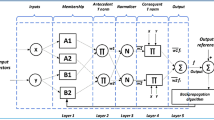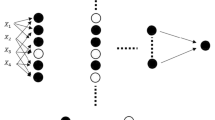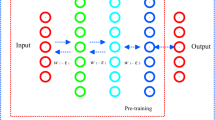Abstract
Predicting the penetration rate of tunnel boring machine (TBM) is a complex and challenging task that plays a crucial role in the schedule planning and cost estimation of tunneling projects. In this study, Mutual Information (MI) is utilized to select the most effective parameters on penetration rate among various rock mass and machine operating parameters. Moreover, Data Envelopment Analysis-Analytic Hierarchy Process (DEA-AHP) approach is implemented in Imperialist Competitive Algorithm-Artificial Neural Network (ICA-ANN) to improve its performance as well as to achieve the best possible architecture of the network. The aforementioned methods are applied on a database consists of 430 data collected from the Lot 2 of Zagros tunnel project. The results indicated that the network with 6 input variables, including uniaxial compressive strength (UCS), Brazilian tensile strength (BTS), distance between the planes of weakness (DPW), rock quality designation (RQD), thrust and revolution per minute (RPM), 9 neurons in the hidden layer and the penetration rate as the output provides the best performance. The determination coefficient (R2) and the mean square error (MSE) indices of the training and testing datasets are 0.901, 0.887, 0.04 and 0.0645, respectively. This study shows that the aforementioned methods could be utilized for enhancing the prediction of the penetration rate of TBMs.









Similar content being viewed by others
Data availability
Enquiries about data availability should be directed to the authors.
References
Afradi A, Ebrahimabadi A (2020) Comparison of artificial neural networks (ANN), support vector machine (SVM) and gene expression programming (GEP) approaches for predicting TBM penetration rate. SN Appl Sci 2(12):1–16
Afradi A, Ebrahimabadi A (2021) Prediction of TBM penetration rate using the imperialist competitive algorithm (ICA) and quantum fuzzy logic. Innovative Infrastructure Solutions 6(2):1–17
Afradi A, Ebrahimabadi A, Hallajian T (2021) Prediction of TBM penetration rate using fuzzy logic, particle swarm optimization and harmony search algorithm. Geotech Geol Eng. https://doi.org/10.1007/s10706-021-01982-x
Aghajani A, Kazemzadeh R, Ebrahimi A (2016) A novel hybrid approach for predicting wind farm power production based on wavelet transform, hybrid neural networks and imperialist competitive algorithm. Energy Convers Manage 121:232–240
Ahmadi MA, Ebadi M, Shokrollahi A, Majidi SMJ (2013) Evolving artificial neural network and imperialist competitive algorithm for prediction oil flow rate of the reservoir. Appl Soft Comput 13(2):1085–1098
An Q, Meng F, Xiong B (2018) Interval cross efficiency for fully ranking decision making units using DEA/AHP approach. Ann Oper Res 271(2):297–317
Armaghani DJ, Mohamad ET, Narayanasamy MS, Narita N, Yagiz S (2017) Development of hybrid intelligent models for predicting TBM penetration rate in hard rock condition. Tunn Undergr Space Technol 63:29–43
Armaghani DJ, Koopialipoor M, Marto A, Yagiz S (2019) Application of several optimization techniques for estimating TBM advance rate in granitic rocks. J Rock Mech Geotech Eng 11(4):779–789
Armetti G, Migliazza MR, Ferrari F, Berti A, Padovese P (2018) Geological and mechanical rock mass conditions for TBM performance prediction. The case of “La Maddalena” exploratory tunnel, Chiomonte (Italy). Tunn Undergr Space Technol 77:115–126
Ashtiani S-HM, Rohani A, Aghkhani MH (2020) Soft computing-based method for estimation of almond kernel mass from its shell features. Sci Hortic 262:109071
Atashpaz-Gargari E, Lucas C (2007) Imperialist competitive algorithm: an algorithm for optimization inspired by imperialistic competition. In: 2007 IEEE congress on evolutionary computation. IEEE, p 4661–4667
Balestrassi PP, Popova E, Paiva Ad, Lima JM (2009) Design of experiments on neural network’s training for nonlinear time series forecasting. Neurocomputing 72(4–6):1160–1178
Barton NR (2000) TBM tunnelling in jointed and faulted rock. CRC Press, Boca Raton
Basheer IA, Hajmeer M (2000) Artificial neural networks: fundamentals, computing, design, and application. J Microbiol Methods 43(1):3–31
Bejou D, Wray B, Ingram TN (1996) Determinants of relationship quality: an artificial neural network analysis. J Bus Res 36(2):137–143
Benardos A, Kaliampakos D (2004) Modelling TBM performance with artificial neural networks. Tunn Undergr Space Technol 19(6):597–605
Bilgin N, Tuncdemir H, Balci C, Copur H, Eskikaya S (2000) A model to predict the performance of tunneling machines under stressed conditions. In: Proceedings of the world tunnel congress of AITES-ITA, Durban, pp 47–53
Brino G, Peila D, Steidl A, Fasching F (2015) Prediction of performance and cutter wear in rock TBM: application to Koralm tunnel project. In: Proceedings of Geoingegneria Ambientale e Mineraria, Turin, pp 41–54
Bruland A (1998) Hard rock tunnel boring: vol 1–10. Ph. D. Thesis, Norwegian University of Science and Technology (NTNU)
Budeba M, Joubert JW, Webber-Youngman R (2015) A proposed approach for modelling competitiveness of new surface coal mines. J South Afr Inst Min Metall 115(11):1057–1064
Charnes A, Cooper WW, Rhodes E (1978) Measuring the efficiency of decision making units. Eur J Oper Res 2(6):429–444
Chong AY-L (2013a) Predicting m-commerce adoption determinants: a neural network approach. Expert Syst Appl 40(2):523–530
Chong AY-L (2013b) A two-staged SEM-neural network approach for understanding and predicting the determinants of m-commerce adoption. Expert Syst Appl 40(4):1240–1247
Cook WD, Kress M (1990) A data envelopment model for aggregating preference rankings. Manage Sci 36(11):1302–1310
Cook WD, Kress M, Seiford LM (1992) Prioritization models for frontier decision making units in DEA. Eur J Oper Res 59(2):319–323
Eftekhari M, Baghbanan A, Bagherpour R (2014) The effect of fracture patterns on penetration rate of TBM in fractured rock mass using probabilistic numerical approach. Arab J Geosci 7(12):5321–5331
Eftekhari M, Baghbanan A, Bayati M (2010) Predicting penetration rate of a tunnel boring machine using artificial neural network. In: ISRM International Symposium-6th Asian Rock Mechanics Symposium. International Society for Rock Mechanics and Rock Engineering
Emrouznejad A, Yang G-l (2018) A survey and analysis of the first 40 years of scholarly literature in DEA: 1978–2016. Socioecon Plann Sci 61:4–8
Engineers SC (2010) Report of geological study and engineering geotechnical of Nowsoud (Zagros) tunnel. Unpublished report
Esmaeilzadeh A, Hadi-Vencheh A (2015) A new method for complete ranking of DMUs. Optimization 64(5):1177–1193
Farmer I, Glossop N (1980) Mechanics of disc cutter penetration. Tunnels and Tunnelling 12(6):22–25
Fraser AM, Swinney HL (1986) Independent coordinates for strange attractors from mutual information. Phys Rev A 33(2):1134
Frénay B, Doquire G, Verleysen M (2013) Is mutual information adequate for feature selection in regression? Neural Netw 48:1–7
Friedman L, Sinuany-Stern Z (1998) Combining ranking scales and selecting variables in the DEA context: the case of industrial branches. Comput Oper Res 25(9):781–791
Ghaleini EN, Koopialipoor M, Momenzadeh M, Sarafraz ME, Mohamad ET, Gordan B (2019) A combination of artificial bee colony and neural network for approximating the safety factor of retaining walls. Eng Comput 35(2):647–658
Gholipour R, Jandaghi G, Rajaei R (2014) Contractor selection in MCDM context using fuzzy AHP. Iran J Manage Stud 7(1):151–173
Giokas DI, Pentzaropoulos G (2008) Efficiency ranking of the OECD member states in the area of telecommunications: a composite AHP/DEA study. Telecommun Policy 32(9–10):672–685
Gong Q-M, Zhao J, Jiao Y-Y (2005) Numerical modeling of the effects of joint orientation on rock fragmentation by TBM cutters. Tunn Undergr Space Technol 20(2):183–191
Gong Q-M, Zhao J, Hefny A (2006a) Numerical simulation of rock fragmentation process induced by two TBM cutters and cutter spacing optimization. Tunnelling and Underground Space Technology 21(3–4)
Gong Q, Jiao Y, Zhao J (2006b) Numerical modelling of the effects of joint spacing on rock fragmentation by TBM cutters. Tunn Undergr Space Technol 21(1):46–55
Gordan B, Koopialipoor M, Clementking A, Tootoonchi H, Mohamad ET (2019) Estimating and optimizing safety factors of retaining wall through neural network and bee colony techniques. Eng Comput 35(3):945–954
Graham PC (1976) Rock exploration for machine manufacturers. In: Proceedings of Exploration for Rock Engineering, Johannesburg, pp 173–180
Green RH, Doyle JR, Cook WD (1996) Preference voting and project ranking using DEA and cross-evaluation. Eur J Oper Res 90(3):461–472
Grima MA, Bruines P, Verhoef P (2000) Modeling tunnel boring machine performance by neuro-fuzzy methods. Tunn Undergr Space Technol 15(3):259–269
Haeri H, Marji MF (2016) Simulating the crack propagation and cracks coalescence underneath TBM disc cutters. Arab J Geosci 9(2):124
Haykin S (1994) Neural networks: a comprehensive foundation. MacMillan College Publishing Co., New York
Hornik K, Stinchcombe M, White H (1989) Multilayer feedforward networks are universal approximators. Neural Netw 2(5):359–366
Howarth D, Roxborough F (1982) Some fundamental aspects of the use of disc cutters in hard-rock excavation. J South Afr Inst Min Metall 82(11):309–315
Huoh Y-J (2013) Sensitivity analysis of stochastic simulators with information theory. UC Berkeley
Innaurato N, Mancini A, Rondena E, Zaninetti A (1991) Forecasting and effective TBM performances in a rapid excavation of a tunnel in Italy. In: Proceeding of the 7th International Congress ISRM, Aachen, pp 1009–1014
Jahanshahloo G, Afzalinejad M (2006) A ranking method based on a full-inefficient frontier. Appl Math Model 30(3):248–260
Jing L-j, Li J-b, Yang C, Chen S, Zhang N, Peng X-x (2019) A case study of TBM performance prediction using field tunnelling tests in limestone strata. Tunn Undergr Space Technol 83:364–372
Khandelwal M, Armaghani DJ (2016) Prediction of drillability of rocks with strength properties using a hybrid GA-ANN technique. Geotech Geol Eng 34(2):605–620
Kraskov A, Stögbauer H, Grassberger P (2004) Estimating mutual information. Phys Rev E 69(6):066138
Kritikos MN (2017) A full ranking methodology in data envelopment analysis based on a set of dummy decision making units. Expert Syst Appl 77:211–225
Kurt MB, Sezgin N, Akin M, Kirbas G, Bayram M (2009) The ANN-based computing of drowsy level. Expert Syst Appl 36(2):2534–2542
Lee Y, Oh S-H, Kim MW (1991) The effect of initial weights on premature saturation in back-propagation learning. In: IJCNN-91-Seattle international joint conference on neural networks. vol 1. IEEE, p 765–770
Li G, Wang W, Jing Z, Zuo L, Wang F, Wei Z (2018) Mechanism and numerical analysis of cutting rock and soil by TBM cutting tools. Tunn Undergr Space Technol 81:428–437
Liao D, Valliant R (2012) Variance inflation factors in the analysis of complex survey data. Surv Methodol 38(1):53–62
Lin M-I, Lee Y-D, Ho T-N (2011) Applying integrated DEA/AHP to evaluate the economic performance of local governments in China. Eur J Oper Res 209(2):129–140
Ling FYY, Liu M (2004) Using neural network to predict performance of design-build projects in Singapore. Build Environ 39(10):1263–1274
Liu H, Kou S, Lindqvist P-A, Tang C (2002) Numerical simulation of the rock fragmentation process induced by indenters. Int J Rock Mech Min Sci 39(4):491–505
Liu JS, Lu LY, Lu W-M, Lin BJ (2013) A survey of DEA applications. Omega 41(5):893–902
Marji MF (1997) Modeling of cracks in rock fragmentation with a higher order displacement discontinuity method. Dissertation, Middle East Technical University, Ankara, Turkey
Marji MF (2015) Simulation of crack coalescence mechanism underneath single and double disc cutters by higher order displacement discontinuity method. J Cent South Univ 22(3):1045–1054
Marji M, Hosseini Nasab H, Hossein Morshedi A (2009) Numerical modeling of crack propagation in rocks under TBM disc cutters. J Mech Mater Struct 4(3):605–627
Moayedi H, Armaghani DJ (2018) Optimizing an ANN model with ICA for estimating bearing capacity of driven pile in cohesionless soil. Eng Comput 34(2):347–356
Mohamad ET, Faradonbeh RS, Armaghani DJ, Monjezi M, Abd Majid MZ (2017) An optimized ANN model based on genetic algorithm for predicting ripping production. Neural Comput Appl 28(1):393–406
Mohammadi A, Sadeghi M, Shojaei P, Rezaei A (2017) Evaluating the efficiency of Iran’s provincial tax offices and ranking them by DEA/AHP. Iran J Manage Stud 10(3):729–750
Moon T, Oh J (2012) A study of optimal rock-cutting conditions for hard rock TBM using the discrete element method. Rock Mech Rock Eng 45(5):837–849
Moosmayer DC, Chong AY-L, Liu MJ, Schuppar B (2013) A neural network approach to predicting price negotiation outcomes in business-to-business contexts. Expert Syst Appl 40(8):3028–3035
Ozdemir L, Miller R, Wang F (1978) Mechanical tunnel boring prediction and machine design, Report to National Science Foundation, Colorado School of Mines, Golden
Park C, Park C, Synn J, Sunwoo C, Chung S (2001) TBM penetration rate with rock mass properties in hard rock. In: Proceedings of the AITES-ITA 2001 World Tunnel Congress, Milan, pp 413–419
Qi G, Zhengying W, Hao M, Qiao C (2016) Numerical and experimental research on the rock-breaking process of tunnel boring machine normal disc cutters. J Mech Sci Technol 30(4):1733–1745
Rezaei A, Hassani H, Tziritis E, Mousavi SBF, Jabbari N (2020) Hydrochemical characterization and evaluation of groundwater quality in Dalgan basin, SE Iran. Groundwater Sustain Develop. https://doi.org/10.1016/j.gsd.2020.100353
Ribacchi R, Fazio AL (2005) Influence of rock mass parameters on the performance of a TBM in a gneissic formation (Varzo Tunnel). Rock Mech Rock Eng 38(2):105–127
Rossi F, Lendasse A, François D, Wertz V, Verleysen M (2006) Mutual information for the selection of relevant variables in spectrometric nonlinear modelling. Chemom Intell Lab Syst 80(2):215–226
Rostami J (1997) Development of a force estimation model for rock fragmentation with disc cutters through theoretical modeling and physical measurement of crushed zone pressure. Dissertation, Colorado School of Mines, Colorado, USA
Rostami J (2013) Study of pressure distribution within the crushed zone in the contact area between rock and disc cutters. Int J Rock Mech Min Sci 57:172–186
Rostami J, Ozdemir L (1993) A new model for performance prediction of hard rock TBMs. In: Proceedings of rapid excavation and tunneling conference, Boston, Massachusetts, pp 793–809
Roxborough FF, Phillips HR (1975) Rock excavation by disc cutter. International journal of rock mechanics and mining sciences & geomechanics abstracts, vol 12. Elsevier, Amsterdam, pp 361–366
Saaty T (1980) The Analytic Hierarchy Process Mcgraw Hill, New York. Agricultural Economics Review 70
Salimi A, Esmaeili M (2013) Utilising of linear and non-linear prediction tools for evaluation of penetration rate of tunnel boring machine in hard rock condition. Int J Mining Mineral Eng 4(3):249–264
Salimi A, Rostami J, Moormann C, Delisio A (2016) Application of non-linear regression analysis and artificial intelligence algorithms for performance prediction of hard rock TBMs. Tunn Undergr Space Technol 58:236–246
Sanio H (1985) Prediction of the performance of disc cutters in anisotropic rock. International journal of rock mechanics and mining sciences & geomechanics abstracts, vol 22. Elsevier, Amsterdam, pp 153–161
Sapigni M, Berti M, Bethaz E, Busillo A, Cardone G (2002) TBM performance estimation using rock mass classifications. Int J Rock Mech Min Sci 39(6):771–788
Sato K (1991) Prediction of disc cutter performance using a circular rock cutting rig. In: Proceedings of the First International symposium on Mine Mechanization, vol 1. Golden, Colorado, pp 31–40
Sexton RS, Johnson RA, Hignite MA (2002) Predicting internet/e‐commerce use. Internet research
Shayeghi H, Ahmadpour A, Heiran MMHK (2017) Optimal operation of wind farm in presence of pumped-storage station as smart infrastructure and load estimation using artificial neural networks. In: 2017 Smart Grid Conference (SGC). IEEE, p 1–7
Singh T, Kanchan R, Saigal K, Verma A (2004) Prediction of p-wave velocity and anisotropic property of rock using artificial neural network technique
Sinuany-Stern Z, Mehrez A, Hadad Y (2000) An AHP/DEA methodology for ranking decision making units. Int Trans Oper Res 7(2):109–124
Snowdon R, Ryley M, Temporal J (1982) A study of disc cutting in selected British rocks. International journal of rock mechanics and mining sciences & geomechanics abstracts, vol 19. Elsevier, Amsterdam, pp 107–121
Steuer R, Kurths J, Daub CO, Weise J, Selbig J (2002) The mutual information: detecting and evaluating dependencies between variables. Bioinformatics 18(suppl_2):S231–S240
Sundaram N, Rafek A, Komoo I (1998) The influence of rock mass properties in the assessment of TBM performance. In: Engineering geology: a global view from the Pacific Rim. p 3553–3559
Sutha K, Tamilselvi JJ (2015) A review of feature selection algorithms for data mining techniques. Int J Comput Sci Eng 7(6):63
Svozil D, Kvasnicka V, Pospichal J (1997) Introduction to multi-layer feed-forward neural networks. Chemom Intell Lab Syst 39(1):43–62
Tarkoy PJ (1974) Predicting tunnel boring machine (TBM) penetration rates and cutter costs in selected rock types. In: Proceedings of 9th Canadian Rock Mechanics Symposium, Montreal, pp 263–274
Tashayo B, Behzadafshar K, Tehrani MS, Banayem HA, Hashemi MH, Nezhad SST (2019) Feasibility of imperialist competitive algorithm to predict the surface settlement induced by tunneling. Eng Comput 35(3):917–923
Tseng Y-F, Lee T-Z (2009) Comparing appropriate decision support of human resource practices on organizational performance with DEA/AHP model. Expert Syst Appl 36(3):6548–6558
Verma AK, Singh TN (2011) Intelligent systems for ground vibration measurement: a comparative study. Eng Comput 27(3):225–233
Wang X, Tang Z, Tamura H, Ishii M, Sun W (2004) An improved backpropagation algorithm to avoid the local minima problem. Neurocomputing 56:455–460
Wang W, Ying L, Zhang J (2016) On the relation between identifiability, differential privacy, and mutual-information privacy. IEEE Trans Inf Theory 62(9):5018–5029
Xiong B, Newton S, Li V, Skitmore M, Xia B (2019) Hybrid approach to reducing estimating overfitting and collinearity. Eng Constr Archit Manage. https://doi.org/10.1108/ECAM-08-2018-0353
Yagiz S, Karahan H (2011) Prediction of hard rock TBM penetration rate using particle swarm optimization. Int J Rock Mech Min Sci 48(3):427–433
Yang H, Wang H, Zhou X (2016) Analysis on the rock–cutter interaction mechanism during the TBM tunneling process. Rock Mech Rock Eng 49(3):1073–1090
Yu D, An S, Hu Q (2011) Fuzzy mutual information based min-redundancy and max-relevance heterogeneous feature selection. Int J Comput Intell Syst 4(4):619–633
Zhang G, Wang M, Liu K (2019) Forest fire susceptibility modeling using a convolutional neural network for Yunnan province of China. Int J Disaster Risk Sci 10(3):386–403
Funding
The authors declare that no funds, grants, or other support were received during the preparation of this manuscript.
Author information
Authors and Affiliations
Corresponding author
Ethics declarations
Conflict of interest
The authors declare that they have no known competing financial interests or personal relationships that could have appeared to influence the work reported in this paper.
Additional information
Publisher's Note
Springer Nature remains neutral with regard to jurisdictional claims in published maps and institutional affiliations.
Rights and permissions
About this article
Cite this article
Eftekhari, M., Eftekhari, N. A Predictive Model for Estimating the TBM Penetration Rate Based on Hybrid ICA-ANN and DEA-AHP Algorithms. Geotech Geol Eng 40, 3191–3209 (2022). https://doi.org/10.1007/s10706-022-02086-w
Received:
Accepted:
Published:
Issue Date:
DOI: https://doi.org/10.1007/s10706-022-02086-w




